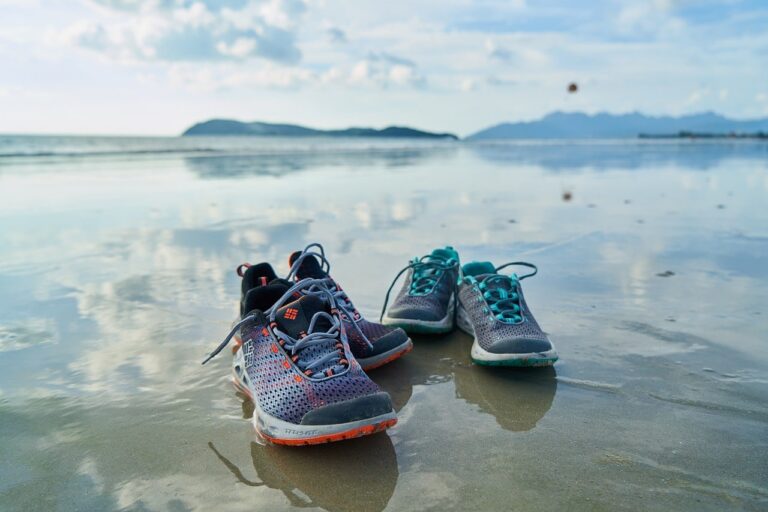HOW SHOULD TRAIL RUNNING SHOES FIT
There’s something about the act of trail running that makes the miles fly by. The vast open spaces and the fresh air and the sense of achievement are all extremely satisfying. And while running in the woods has its own unique set of challenges, good trail running shoes can make all the difference.
To fit these shoes perfectly, you need to understand how they fit and what you need to look for in a good fit. In this blog post, we’ll explore top tips on how to fit your trail running shoes and help you find the perfect pair that will fit your feet like a glove.
How should trail running shoes fit? Pro tips
Finding the right fit for your trail running shoes can be a daunting task. But with a little bit of trial and error, you’ll be good to go. When fitting trail running shoes, make sure that you wiggle your feet into them, level the heel, and fit them snugly. Be sure to try different sizes to find the perfect fit – sometimes one or two sizes up will do the trick. Finally, make sure the shoes fit comfortably and don’t feel like they’re going to fall off when you’re running.
Comfortable support
When it comes to fitting trail running shoes, there are a few key things to keep in mind. The support and stability you need in a shoe comes from the construction of the shoe itself. Make sure the toe box is wide enough to distribute weight evenly across your foot, as well as room for socks or an over-the-top insert (like orthotics). Additionally, a stable heel is essential – this is usually made out of durable materials like carbon fiber or Kevlar.
Finally, fit the shoe snugly but not so tightly that you can’t move or feel your feet. Trail running shoes should fit snugly but not so tight that you can’t wear them comfortably for long runs.
Heel hug
Trail running can be a challenging activity, but the right shoe can make the difference between a good and great run. When fitting trail running shoes, it’s important to keep the heel hug in mind. This is the snug fit on the heel that doesn’t cause discomfort. If the shoe feels too tight, try a larger size or another style of trail running shoe.
Additionally, trail running shoes should fit snugly on your heel but not so tight that they cause discomfort. When you’re looking for the latest pair of trails running sneakers, make certain to test them personally. The heel hug test can help to determine if a trail runner’s shoe is the right fit for them based on their individual foot shape and weight distribution. So, go out and have some fun. You might just end up enjoying your runs even more.
How does it lace?
The right pair of shoes for trail running can be an overwhelming task. You not only need to determine the proper size for your shoe and style, but you must also to ensure that the fit is comfortable and comfortable. To do this, lace the shoe up snugly but allow enough room to easily adjust the laces. Additionally, make sure the shoe has a good arch support and fit snugly around your heel and toe.
If you’re having difficulty getting the right fitting, think about using an elastic lacing method. Last but not least make sure to check the fit of the shoe when shopping. Running shoes for trail are available in a range of styles and sizes, making it crucial to choose the right pair that fits you.
Toe “wiggle” space
Trail running shoes fit a little bit differently than running shoes designed for road running. To fit for trail running, first measure the width of your shoe at the widest point of your foot (around the big toe). For those with wider feet or high arches, size up one full size in order for more wiggle space.
In order for your feet to move as smoothly and freely in your shoes as possible, it is important to leave plenty of room in the toes “wiggle” space. If this measurement falls within a half-size range from one shoe to another, then you should be good to go.
Cushioning
When it comes to trail running shoes, cushioning is key. Not only do they provide a stable surface for your feet to land on, but they can also provide a good amount of shock absorption.
What kind of cushioning should you search for in the trail running shoes? Our range of shoes offers great cushioning for a variety of feet sizes and shoe widths. If you’re in between sizes, go for the larger size to give you more room to breathe and move around in your shoe. Make sure you have proper foot alignment when wearing trail running shoes so you can maximize ankle support and movement.
Finally, be sure to size your trail running shoe a little larger than street shoe size for greater cushioning and shock absorption.
Good grip
Running shoes are fantastic ways to get your heart rate up and burn some calories. However, fitting the right trail running shoes is crucial for a great experience. Make sure to consider the following features:
reinforced wear areas and drainage holes; a narrow fit to prevent foot movement; and a good grip on the ground. Be sure to try on the shoes in-store first to get a good fit, or go for a trail running shoe trial run to ensure you’re getting the perfect shoe for your feet. Last but not least, make sure to select shoes that fit snugly to provide a good grip on the ground.
Forefoot room
Choosing the right trail running shoes can be a daunting task. But don’t worry, we’re here to help. When specifying if you have wide or narrow feet, it’s important to remember that not all trail running shoes fit all feet the same. Test various models until you find the right size.
Additionally, make sure that the space for your forefoot is adequate to accommodate your foot. This can reduce the amount of pressure that is placed on the ball and toes of your foot. This will as a result, ensure that the shoe is properly fitted. So don’t delay any longer and purchase the ideal pair of running shoes for trail running today.
Conclusion
If you’re looking for the perfect fit for trail running, keep reading. In this blog, we’ll go over the different factors that should be taken into account when fitting trail running shoes, including the fit of the heel, toe wiggle space, cushioning, and grip. We hope this guide will help you find the perfect pair of shoes for your running adventures.
FAQs
How do I know if my current trail running shoes are fitting properly?
To fit a trail running shoe correctly, you need to tighten the laces as much as possible while still allowing them some slack. This way, your feet will be snugly secured in the shoe and won’t move around or roll around. Moreover, you should try on different pairs of shoes or socks to see which one gives you the most snug fit.
This way, you can pinpoint the shoe size that best suits your feet’s width and length. Lastly, if your feet are rolling and sliding around in the shoe, it’s not fitting properly.
What are some other considerations that I should take into account when buying trail running shoes?
Here are a few things to consider when buying trail running shoes:
- Make sure the shoe fit well and has a snug fit. This will ensure that the shoe doesn’t slip off your foot while running, and it will also be more comfortable to wear.
- Make sure the shoe is fitted properly to your foot’s shape and size. Too large or too small shoes can cause blisters or other injuries.
- Go for shoes that are made of durable materials and have good traction so you don’t slip on the trail.
Can new trail runners wear the same size of shoes as traditional road runners?
For new trail runners, it is advised to buy shoes that fit within the ball of the foot – this falls within the width of the shoe at its widest point. When choosing a shoe size for trail running, take into consideration your foot width at its widest point. If you have wide feet or are on the cusp of getting wider feet, then go for a wider shoe size instead.
What type of foot strike should I use when running on trails?
When running on trails, you should use a heel-toe strike. This type of foot strike puts less pressure on the front of your feet and helps in avoiding injuries. It’s also important to land on your forefoot as much as possible to reduce the risk of blisters or sprained ankles.







